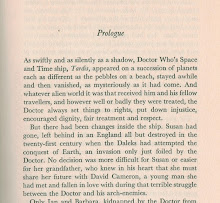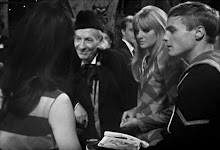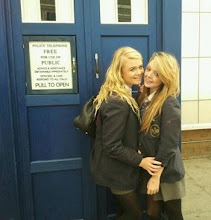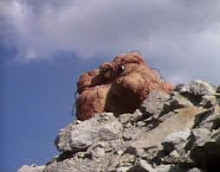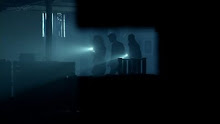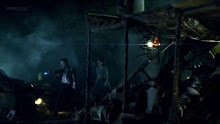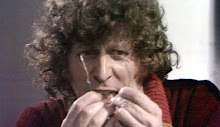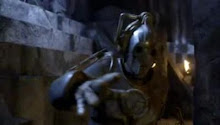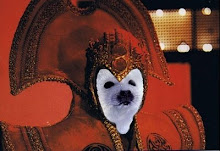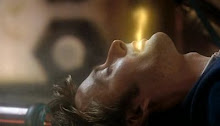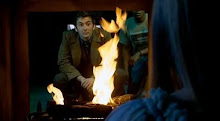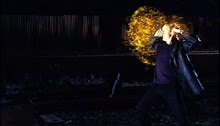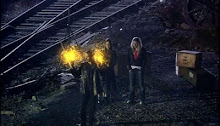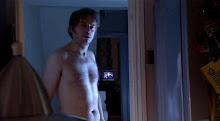
Secretly, this is about my cousin. His name is Steven, and he's now a doctor of cybernetics. This could have been predicted by anyone who'd witnessed even a fraction of his early life. In 1979, when I was seven and he was sixteen - he having been born in 1963, a trait of many notables in this chronology, from Tat Wood to Jarvis Cocker - he was the first person I knew who owned a home computer. The machine was a NASCOM-1, a conglomeration of boxes, cables, and sharp-toothed circuitry which just two ZX-years later would have all the cutting-edge appeal of a Spinning Jenny. The more remarkable point is that when he was in his seventeenth year, an age at which you and you and you and I were all watching pop videos and doing terrible things to our own bodies, my cousin Steven built the NASCOM-1 himself out of its component parts. This wasn't necessity: in that early period, computers came in kit form or complete, the latter being slightly less affordable. Like me, Steven had a fundamentalist middle-class upbringing, though he lived in a nicer house. I'm fairly sure his family, sensing as all parents did that computers were the Coming Thing, would have been happy to chip in the extra in order to fast-track him towards the inevitable future of AI-run governments and chunky digital lettering.
No. Steven had the kit-form NASCOM-1 because he wanted to put it together himself. He wanted to solder the chips to the boards, the boards to the framework, to understand how exactly what was happening in its electro-guts when the lurid green hexdecimal began to fill up the screen. I have profound memories of his hunched, athletic form (because I fear that the "geek" stereotype had no meaning in 1979, my cousin being a Sports Day champion, as well as an individual whom a girlfriend of mine - twenty years on - would describe with the single syllable "mmMMmm"), poised with a soldering iron in his hand as if he were a Soviet figurative sculpture of the microchip age. Over a period of weeks, I watched the Black Box of the CPU take shape in time-lapse, until the day came when he could switch it on. It worked without hitches or glitches, which is perhaps the least likely thing in this whole narrative.
This is supposed to be about Doctor Who, though. So given all of that as a prologue:
October, 1979. I'm with my mother in the newsagent's between home and school, between here and elsewhere, the suburban middle-ground into which I'm forbidden to journey alone. She's popped into this shop for... oh, God knows what. This is the time of Wavy Line and MacFisheries, and the rules of corner-shopping are different. Something, however, catches my eye on the sort of wire-frame rotating rack that may or may not still exist in your century. A comic... no, it's a magazine. Or...
"Oh!" says my mother, following my eyeline and seizing it from its nest. "It's a Doctor Who Weekly. There are free transfers, look."
What?
What?
A year earlier, I'd bought (very well.. I'd been bought, I was six and I shouldn't be embarrassed about my lack of financial independence) Star Wars Weekly, at least until the comic-strips based on the actual film had dried up and they'd started printing some blather about Jabba the Hutt being a chimpanzee. Star Wars Weekly had been a top seller at the time, getting its own TV ad with C-3PO explaining its benefits, in preparation for his Currys work thirty years later. Off-screen sources were as important for Star Wars as The Making of Doctor Who - with its definitive list of all stories up to "The Hand of Fear", priceless at this stage - had been for those of us who believed we were representing the Old Religion as well as the New. With hindsight, yes, it was the success of the Star Wars title that led Marvel Comics' UK wing to think it could copy the format for Doctor Who. Modern fandom appears to have brushed this aside, as if a Doctor Who publication were an inevitabiliy, and therein lies the source of my surprise. I had no warning that such a publication had been launched, and therefore...
What?
I knew, even then, that Doctor Who had been around for sixteen years. And as I'd never been permitted to investigate this particular shop before, I naturally assumed that a weekly treasury of posters and parallel-adventures had been in existence for ages, but that I was only now eligible to read it. Then a little red-and-yellow bubble in one corner informed me, in the sort of writing I now associate with Jack Kirby, that this was the first issue. I honestly believed it had to be some sort of mistake. This can't be the first issue, can it? My cousin Steven collects Marvel comics. Some of his are quite rare, I'm told. Should we inform him of this? It must have been sitting in the rack for years. In reality, we must be up to issue #1,000,000 by now.
You may notice a certain increase in enthusiasm since 1978. This is largely because Doctor Who had come back to TV in September 1979, on a shockwave of publicity, and... had done everything right.
It's not in my nature to describe the Terry Nation landfill of "Destiny of the Daleks" that way, especially when its disco-wig androids made the gap between Boney M and Outer Space seem narrower still. As I've suggested before, what's weak with the eye of hindsight may have been startling at the time, or at least perfectly-camouflaged for its own historical environment. "Destiny of the Daleks", in so many ways an archetypal (or my archetypal) sterile, cardboard-flavoured Graham Willaims story, did its job beautifully. It brought back Daleks, for those of us who had no living memory of them but somehow knew exactly what they sounded like, a knowledge passed down to us like an older sibling's clothes. It put the Doctor in the middle of a war between two inhuman factions, dead on-key for the cinematic SF of the time, but also suggestive of the news stories that even us young-'uns had seen about Idi Amin in Uganda or the "unpleasantness" in Iran. It regenerated Romana in a way that, first time around, seemed too bizarre to be silly. Then it put her in a slave-camp, let her feign her own death in order to dig her way out of a shallow grave, and dumped her in a plastic explodo-tube as a cliffhanger. It strapped yellow canisters to Dalek suicide bombers and showed us Daddy Cool robots being confused by rock-scissors-paper. It ended with Davros on ice.
No other story I can think of looks so crass now, but seemed so clued-up at the time. No other story so divides my childhood self and grown-up self. I was obsessed with it. Later I was obsessed with the Target novelisation of it, even noting the minor differences in the Doctor's "all elephants are pink" schtick. It renewed my interest in TV-Doctor Who, as nothing in what we now call Season Sixteen could have done. Maybe because, despite all its in-jokes and Douglas Adams' best attempts to make the series swallow its own tail, so many people on-screen were treating the story as if it actually mattered (Tyssan was yet another Terry Nation / Gerry Anderson hybrid, a crash survivor of the XL-5, but this time he looked as if he'd just made it out of a concentration camp). By the end of this year, that wouldn't be the case.
But then there was "City of Death".
The most obvious thing to say here is that it had the highest ratings of any Doctor Who story, not Morecambe and Wise-level but certainly in the same league; the second-most obvious thing to say is that this was due to a strike at ITV. Many claims and counter-claims have been made as to whether this strike was actually in progress during the transmission of episodes X, Y, Z, and N, but I believe I speak for everyone who saw it on first broadcast when I say that I don't care. "City of Death" was right, from first to last. Matt Irving's modelwork in the opening scene, a spider-engine crouched on a cracked prehistoric landscape, a spaceship as singular as those in Star Wars were dynamic. The beautifully-costumed thing in the cockpit, seaweed with a sense of space-chic. The seemingly unconnected first episode, criticised for its "running through Paris" sequences now, but so unlike what we'd come to expect (pre-'80s, going to France was as exotic as scuba diving) that even the clumsy crack-in-time sequence seemed enticing and mysterious. Then, finally, the cliffhanger. Also much-derided with hindsight, also fantastic when you don't know how these elements are meant to fit together. Oh, I see! He's the thing from the opening sequence? Right, got it. Cliffhanger not just as set-piece, but as narrative turning-point, the way it's meant to be.
In retrospect, the plot of "City of Death" makes less sense than any story since "The Wheel in Space". It's a children's-hour version of the universe, where a space-monster makes a time machine by keeping a scientist with a funny accent in his basement, where events are only linked by monstrous coincidences, where the shock of seeing Scaroth in the Renaissance blanks out the numerous questions as to how the Hell this could possibly work. But if we cared about reason, none of us would like "Genesis of the Daleks". Twelve years later, teen-me would have a 'phone conversation with teen-best-friend (one who watched Doctor Who as a child, but not obsessively), and tell him I'd got that story on video. You know, with the one-eyed seaweed-monster...? He'll be non-plussed, and at that moment, my mother will walk past me in the hallway. She'll say: "Tell him it's the one with the six Mona Lisas." I will. He'll immediately respond: "Oh, that one!"
Y'see, it's not always the monsters that stick.
I fear this can't last. Both the collective memory of fandom and the column-inches of the Sun would come to reinforce a banal vision of the programme in this phase, a version in which children mainly watch the show for K-9. Yet these two stories, most precisely-targeted of their era even if one of them looks a dance-off in a gravel pit, don't feature a functioning K-9 at all. The next story will, and many of us will grow bored with it after episode one. The same will be true of "Nightmare of Eden", in which only the weirdness of Mandrels' legs will keep us watching, however good the premise looks on paper. "The Horns of Nimon"... for me, its greatest contribution was the presence of its lead monster at an exhibition in Madame Toussaud's, the following year. It lurked in the darkness, but lit up and bellowed when my mother walked past. As I believe I've mentioned, she had a deep-rooted psychosexual horror of / fascination with minotaurs. Hilarity ensued, at least for me.
The story itself, when broadcast, merely matched "Underworld" in taking a primal, terrifying myth and turning it into a gutless circuit-diagram of grey corridors and demi-science. Worse, it wasted Graham Crowden's one shot at Doctor Who. Soldeed's pop-eyed madness at the end of episode three genuinely bothered me, as a stoic seven-year-old, and remains the only part of the story to provoke any response at all. Other than irritation.
Funny. I never met my father, and I was uncommonly hairy even before puberty. I was just thinking about Pasiphaë, and... no, it's not important.
But these betrayals were yet to come. In the middle of "City of Death", Doctor Who Weekly appeared, and this was a bigger shift of expectations than anything the BBC could provide. In the texty middle-layer of DWW, we were given weekly breakdowns of what had happened in every Doctor Who story, beginning at the beginning. The Making of Doctor Who had compressed these legends of the ancestors into a single paragraph per story code, but now there was a blow-by-blow reconstruction which didn't claim that Ian and Barbara met in the fog on Barnes Common before immediately embarking on a trip to Skaro. Yeah, I'd got wise to Target's trickery. On either side of the "historical" matter (and a regular page inspired by Ripley's Believe It Or Not, in which we were informed of Tibetan yak-butter tea... not something you can simulate with margerine, I discovered), there were the comic-strips. Of vastly more weight than those in TV Comic or the insipid annuals, purely because they were created by the champions of the bloody-snouted 2000 AD generation. "The Iron Legion", the alter-universe epic that ran from #1 to #8 and has been reprinted in endless forms since, was by Pat Mills, John Wagner, and Dave Gibbons. The creators of Judge Dredd and the artist of Watchmen. It was a masterpiece.
Early instalments of "The Iron Legion" accompanied "City of Death", and these two conflicting versions of the Doctor Who universe co-existed beautifully. Even then, we had a sense that nothing shot at TV Centre could actually show us an army of Roman Legionnaire robots in full battle-mode, but that didn't matter: instead it gave us the close-up conflict of the Doctor and Scarlioni, Tom Baker and Julian Glover. "City of Death" works, for all the yawning improbabilities, because the lead characters form a gravitational system of their own. Time Lord and Jagaroth, circling each other like suns about to collide, with Romana as the major planetary mass (never mind accurate, is it even legal to describe Lalla Ward as a gas giant...?) who might swing the balance. In the end, it's the tiny moon of Duggan that makes a difference. Matt Irving's effects are lovely book-ends, but not the main attraction, as they might be post-CGI. This isn't an epic, and doesn't try to be. "The Iron Legion", that's our mythology in epic form, with at least as much wit, invention, and humanity as what we considered "real". Before this point, no off-telly vision of Doctor Who could have claimed to be neck-and-neck with the BBC's. "The Fishmen of Kandalinga" would be a let-down even compared to the weakest of Hartnell serials. Now that had changed.
So when "Nimon" shrank the format back into Doctor, monsters, and corridors... you can see the problem, I think. We'd already witnessed the villainy of General Ironicus, the giggling weirdness of the Ectoslime, and the imperious horror of the Malevilus (the latter echoing the psychic pterodactyls of At the Earth's Core, which doesn't exactly bring us full-circle, but does create a pleasant link to Peter Cushing's battle-cry of "you can't hypnotise me, I'm British"). Tom Baker slouching around yet another tinfoil planet, treating the monsters-of-the-month with such contempt that they never seemed any threat at all, was a poor substitute. These days we know the original script was a worse proposition still, the Nimon (or Nimons, the plural remains contentious) removing their horn'ed masks and revealing themselves to be poxy mini-aliens dressing up as minotaurs in order to scare the natives. Even those who claim this story was a witty, ironic attempt to offload all the clichés of Doctor Who - and it wasn't - can't escape the accusation that it felt like a stab in the back even at the time of broadcast, yet the Scooby-Doo ending would've put the series on a permanent cartoon footing. "It's a MisterJenkinsonoid, the caretaker-race from disused planet Fairgroundus 6!"
This is, as you'll gather, purely a description of the early phase of the Doctor Who Weekly / Monthly / Magazine comic-strip. Beyond the mid-'80s, it was devised by fans or friends of Gary Russell rather than comic-book people; even Paul Cornell, now arousing more of my jealousy than almost any other individual by being safe in the bosom of DC, couldn't match the intensity of the early issues. Alan Moore's back-up strips were an obvious influence on both Marc Platt's view of ye olde Gallifrey and my view of its future ("Alien Bodies" shares 95% of its DNA with its closest relative, "4-D War"). Abslom Daak was created by a writer who had a general contempt for Doctor Who but liked anti-heroes with chainsaws, effectively Moffat with a better sense of what would work visually, yet even he supplied enough Dalek-rending action to become legendary. If we'd begun to suspect that Doctor Who existed far beyond the transmission, then here was the proof in literal black and white. 1979 showed us everything the TV series could do, and everything it should stop doing; hinted at what the Doctor might get up to when removed from the studio floor, and reminded us that we still needed a baseline that didn't involve Han Solo substitutes cutting Daleks' heads off, fun as they may be in the short term.
It seemed only natural, at the time, that this new weekly link to Doctor Who past and future should come from Marvel. The Marvel universe was my third-favourite mythology. Throughout the '70s, my cousin had read everything from Spider-Man to the much-undervalued Warlock, and had kept older oddities like the Marvel series based on 2001: A Space Odyssey (drawn by Kirby, one issue concluding with the fabulous caption "NEXT: VIRA THE SHE-DEMON!", something that surely would have been featured in the movie if Kubrick had thought of it). He'd taught me the canon without really intending to. I've never read a comic that features Annihilus, but I know exactly who he is and what he did to earn that manner of Villain Name. I went with Steven to meet Stan Lee at the Roundhouse in London, in... ohhh, 1976 or thereabouts. The Roundhouse staff had plastered the restaurant area with pages from Marvel back-issues, just as I'd plastered my own bedroom with pages from The Doctor Who Monster Book, heavily-muscled butterflies pinned to walls that sweated grease. I remember being fascinated by this, far more than by the weird man with the moustache who talked to my cousin for a bit and may have signed something.
A shared universe. An ever-growing pantheon. Did my cousin teach me that, deliberately or otherwise? Was my own internal Doctor Who pounded into shape by the mighty fist of Marvel (Excelsior!), or specifically by stories like "The Iron Legion", "City of the Damned", "Time Witch", "The Dogs of Doom", and - most interesting of all, since it not only understood the nature of Doctor Who far better than the programme's lead actor did, but even resembles the 2005 version if you can imagine it updated with mobile 'phones and a token reference to Chavs - "Star Beast"?
Steven also taught me how to program computers. This has proved a worthless skill in itself, since computers in our epoch don't like being programmed directly, and their complexity relies on strata of pre-existing code to which I've never been formally introduced. Programming is, however, a worthwhile lesson in logic. Not enough logic to stop me having my suspicions, mind: his first, middle, and surnme each have six letters, he was born on the sixth day of the sixth month, and he refused to let me check his scalp for the tell-tale birthmark after I'd seen The Omen. Now he has his PhD in Artificial Intelligence, he may still prove to be the Anti-Christ by building Anti-God. In which case, fair play to him. One of my twelve historical fragments still regards him with some resentment, since members of my family have long used him as the yardstick by which to measure my own development, and I definitely couldn't build a computer by the time of "Remembrance of the Daleks". But overthrowing the natural order of creation would be a significant result for him.
And he taught me about Dr Octopus. That's as important as your dad showing you how to shave.




















